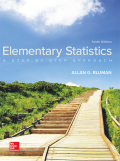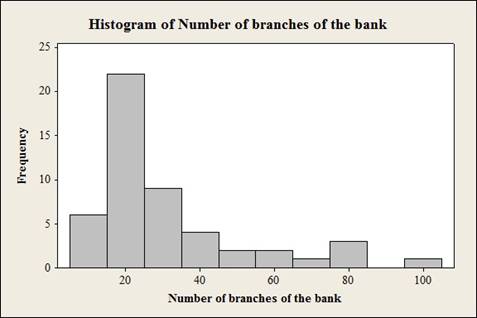
Concept explainers
Many times in statistics it is necessary to see if a set of data values is approximately
The numbers of branches of the 50 top banks are shown.

1. Construct a frequency distribution for the data.
2. Construct a histogram for the data.
3. Describe the shape of the histogram.
4. Based on your answer to question 3, do you feel that the distribution is approximately normal?
In addition to the histogram, distributions that are approximately normal have about 68% of the values fall within 1 standard deviation of the
5. Find the mean and standard deviation for the data.
6. What percent of the data values fall within 1 standard deviation of the mean?
7. What percent of the data values fall within 2 standard deviations of the mean?
8. What percent of the data values fall within 3 standard deviations of the mean?
9. How do your answers to questions 6, 7, and 8 compare to 68, 95, and 100%, respectively?
10. Does your answer help support the conclusion you reached in question 4? Explain.
1.
To construct: The frequency distribution for the data.
Answer to Problem 1AC
The frequency distribution for the data is,
| Limits | Frequency |
| 0-9 | 1 |
| 10-19 | 14 |
| 20-29 | 17 |
| 30-39 | 7 |
| 40-49 | 3 |
| 50-59 | 2 |
| 60-69 | 2 |
| 70-79 | 1 |
| 80-89 | 2 |
| 90-99 | 1 |
Explanation of Solution
Given info:
The data shows that the number of branches of the 50 top banks.
Calculation:
Answers may vary; one of the possible answers is given below.
First consider the limits with the difference of 9.
The limits are 0-9, 10-19, 20-29, 30-39, 40-49, 50-59, 60-69, 70-79, 80-89 and 90-99.
From the data, it can be observed that the number banks having branches between 0-9 is 1. Also, the number banks having branches between 10-19 is 14.
Similarly, the frequencies of other classes are obtained as follows.
| Limits | Frequency |
| 0-9 | 1 |
| 10-19 | 14 |
| 20-29 | 17 |
| 30-39 | 7 |
| 40-49 | 3 |
| 50-59 | 2 |
| 60-69 | 2 |
| 70-79 | 1 |
| 80-89 | 2 |
| 90-99 | 1 |
2.
To construct: The histogram for the data.
Answer to Problem 1AC
The histogram for the data is,

Explanation of Solution
Calculation:
Step-by-step procedure to obtain histogram using the MINITAB software:
- Choose Graph > Histogram.
- Choose Simple, and then click OK.
- In Graph variables, enter the column of Number of branches of the bank.
- Click OK.
3.
To describe: The shape of the histogram.
Answer to Problem 1AC
The shape of the histogram is unimodel and skewed to the right.
Explanation of Solution
Justification:
From the histogram of part (2), it can be observed that the data has single group and the bar in histogram starts with a high value which is gradually decreasing to the minimum value. Thus, it can be conclude that shape of the histogram is unimodel and skewed to the right.
4.
To check: Whether the distribution is approximately normal or not based on the answer of question 3.
Answer to Problem 1AC
No, the distribution is not approximately normal.
Explanation of Solution
Justification:
From the part (3), it can be observed shape of the histogram is unimodel and skewed to the right. Thus, it can be conclude that the distribution does not appear to be normal.
5.
To find: The mean and standard deviation for the data.
Answer to Problem 1AC
The mean and standard deviation for the data are 31.4 and 20.6.
Explanation of Solution
Calculation:
- Choose Stat > Basic Statistics > Display Descriptive Statistics.
- In Variables enter the columns Variable.
- Choose option statistics, and select Mean and Standard deviation.
- Click OK.
Output using Minitab software is,

Form the Minitab output, it can be observed that the mean and standard deviation for the data are approximately 31.4 and 20.6.
6.
To find: The percent of the data values fall within 1 standard deviation of the mean.
Answer to Problem 1AC
The percent of the data values fall within 1 standard deviation of the mean is 80%.
Explanation of Solution
Calculation:
Here, 1 standard deviation of the mean represents that
Substitute 31.4 for
For
For
The percentage of the data values fall within 1 standard deviation of the mean represents the percentage of the data values lies between 10.8 and 52.
The formula for the percentage of the data values fall within 1 standard deviation of the mean is,
Substitute 40 for “Number of data values lies within 10.8 and 52” and 50 for “Total number of data values”
Thus, the percent of the data values fall within 1 standard deviation of the mean is 80%.
7.
To find: The percent of the data values fall within 2 standard deviation of the mean.
Answer to Problem 1AC
The percent of the data values fall within 2 standard deviation of the mean is 92%.
Explanation of Solution
Calculation:
Here, 2 standard deviation of the mean represents that
Substitute 31.4 for
For
For
The percentage of the data values fall within 2 standard deviation of the mean represents the percentage of the data values lies between –9.8 and 72.6.
The formula for the percentage of the data values fall within 2 standard deviation of the mean is,
Substitute 46 for “Number of data values lies within –9.8 and 72.6” and 50 for “Total number of data values”
Thus, the percent of the data values fall within 2 standard deviation of the mean is 92%.
8.
To find: The percent of the data values fall within 3 standard deviation of the mean.
Answer to Problem 1AC
The percent of the data values fall within 3 standard deviation of the mean is 98%.
Explanation of Solution
Calculation:
Here, 3 standard deviation of the mean represents that
Substitute 31.4 for
For
For
The percentage of the data values fall within 3 standard deviation of the mean represents the percentage of the data values lies between –30.4 and 93.2.
The formula for the percentage of the data values fall within 3 standard deviation of the mean is,
Substitute 49 for “Number of data values lies within –30.4 and 93.2” and 50 for “Total number of data values”
Thus, the percent of the data values fall within 3 standard deviation of the mean is 98%.
9.
To compare: The 6,7 and 8 answers with the 68, 95 and 100%.
Answer to Problem 1AC
The 6,7 and 8 answers are different with the 68, 95 and 100%.
Explanation of Solution
Calculation:
From the answers of 6,7 and 8, it is observed that the percent of the data values fall within 1,2 and 3 standard deviation of the mean are 80%, 92% and 98%. Thus, it can be conclude that the 6,7 and 8 answers are different with the 68, 95 and 100%.
10.
To explain: Whether the answer help to support the conclusion in question 4.
Answer to Problem 1AC
Yes, the answer help to support the conclusion in question 4 because the distribution of the variable does not follow normal distribution.
Explanation of Solution
Calculation:
From the answer of (9), it can be observed that the distribution of the variable does not follow normal distribution. Thus, it can be concluding that the answer help to support the conclusion in question 4.
Want to see more full solutions like this?
Chapter 6 Solutions
Elementary Statistics: A Step By Step Approach
Additional Math Textbook Solutions
Math in Our World
Elementary Statistics ( 3rd International Edition ) Isbn:9781260092561
APPLIED STAT.IN BUS.+ECONOMICS
Introductory Statistics
Basic College Mathematics
Elementary Statistics: Picturing the World (7th Edition)
- Harvard University California Institute of Technology Massachusetts Institute of Technology Stanford University Princeton University University of Cambridge University of Oxford University of California, Berkeley Imperial College London Yale University University of California, Los Angeles University of Chicago Johns Hopkins University Cornell University ETH Zurich University of Michigan University of Toronto Columbia University University of Pennsylvania Carnegie Mellon University University of Hong Kong University College London University of Washington Duke University Northwestern University University of Tokyo Georgia Institute of Technology Pohang University of Science and Technology University of California, Santa Barbara University of British Columbia University of North Carolina at Chapel Hill University of California, San Diego University of Illinois at Urbana-Champaign National University of Singapore McGill…arrow_forwardName Harvard University California Institute of Technology Massachusetts Institute of Technology Stanford University Princeton University University of Cambridge University of Oxford University of California, Berkeley Imperial College London Yale University University of California, Los Angeles University of Chicago Johns Hopkins University Cornell University ETH Zurich University of Michigan University of Toronto Columbia University University of Pennsylvania Carnegie Mellon University University of Hong Kong University College London University of Washington Duke University Northwestern University University of Tokyo Georgia Institute of Technology Pohang University of Science and Technology University of California, Santa Barbara University of British Columbia University of North Carolina at Chapel Hill University of California, San Diego University of Illinois at Urbana-Champaign National University of Singapore…arrow_forwardA company found that the daily sales revenue of its flagship product follows a normal distribution with a mean of $4500 and a standard deviation of $450. The company defines a "high-sales day" that is, any day with sales exceeding $4800. please provide a step by step on how to get the answers in excel Q: What percentage of days can the company expect to have "high-sales days" or sales greater than $4800? Q: What is the sales revenue threshold for the bottom 10% of days? (please note that 10% refers to the probability/area under bell curve towards the lower tail of bell curve) Provide answers in the yellow cellsarrow_forward
- Find the critical value for a left-tailed test using the F distribution with a 0.025, degrees of freedom in the numerator=12, and degrees of freedom in the denominator = 50. A portion of the table of critical values of the F-distribution is provided. Click the icon to view the partial table of critical values of the F-distribution. What is the critical value? (Round to two decimal places as needed.)arrow_forwardA retail store manager claims that the average daily sales of the store are $1,500. You aim to test whether the actual average daily sales differ significantly from this claimed value. You can provide your answer by inserting a text box and the answer must include: Null hypothesis, Alternative hypothesis, Show answer (output table/summary table), and Conclusion based on the P value. Showing the calculation is a must. If calculation is missing,so please provide a step by step on the answers Numerical answers in the yellow cellsarrow_forwardShow all workarrow_forward
 Holt Mcdougal Larson Pre-algebra: Student Edition...AlgebraISBN:9780547587776Author:HOLT MCDOUGALPublisher:HOLT MCDOUGAL
Holt Mcdougal Larson Pre-algebra: Student Edition...AlgebraISBN:9780547587776Author:HOLT MCDOUGALPublisher:HOLT MCDOUGAL Glencoe Algebra 1, Student Edition, 9780079039897...AlgebraISBN:9780079039897Author:CarterPublisher:McGraw Hill
Glencoe Algebra 1, Student Edition, 9780079039897...AlgebraISBN:9780079039897Author:CarterPublisher:McGraw Hill Big Ideas Math A Bridge To Success Algebra 1: Stu...AlgebraISBN:9781680331141Author:HOUGHTON MIFFLIN HARCOURTPublisher:Houghton Mifflin Harcourt
Big Ideas Math A Bridge To Success Algebra 1: Stu...AlgebraISBN:9781680331141Author:HOUGHTON MIFFLIN HARCOURTPublisher:Houghton Mifflin Harcourt Functions and Change: A Modeling Approach to Coll...AlgebraISBN:9781337111348Author:Bruce Crauder, Benny Evans, Alan NoellPublisher:Cengage Learning
Functions and Change: A Modeling Approach to Coll...AlgebraISBN:9781337111348Author:Bruce Crauder, Benny Evans, Alan NoellPublisher:Cengage Learning



